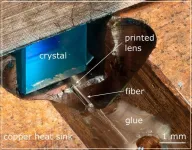(Press-News.org) WASHINGTON — For the first time, researchers have shown that 3D-printed polymer-based micro-optics can withstand the heat and power levels that occur inside a laser. The advance enables inexpensive compact and stable laser sources that would be useful in a variety of applications, including the lidar systems used for autonomous vehicles.
“We significantly reduced the size of a laser by using 3D printing to fabricate high-quality micro-optics directly on glass fibers used inside of lasers,” said research team leader Simon Angstenberger from the 4th Physics Institute at University of Stuttgart in Germany. “This is the first implementation of such 3D-printed optics in a real-world laser, highlighting their high damage threshold and stability.”
In the Optica Publishing Group journal Optics Letters, the researchers describe how they 3D printed microscale optics directly onto optical fibers to combine fibers and laser crystals inside a single laser oscillator in a compact way. The resulting hybrid laser exhibited stable operation at output powers of over 20 mW at 1063.4 nm and had a maximum output power of 37 mW.
The new laser combines the compactness, robustness and low cost of fiber-based lasers with the advantages of crystal-based solid-state lasers, which can have a broad range of properties such as different powers and colors.
“Until now, 3D-printed optics have primarily been used for low power applications such as endoscopy,” said Angstenberger. “The ability to use them with high power applications could be useful for lithography and laser marking, for example. We showed that these 3D micro-optics printed onto fibers can be used to focus large amounts of light down to a single point, which could be useful for medical applications such as precisely destroying cancerous tissue.”
Taking the heat
The 4th Physics Institute at University of Stuttgart has a long history of developing 3D-printed micro-optics, especially the ability to print them directly on fibers. They use a 3D printing approach known as two-photon polymerization, which focuses an infrared laser into a UV sensitive photoresist. In the laser’s focal region, two infrared photons will be absorbed simultaneously, which hardens the UV resist. Moving the focus around allows various shapes to be created with high precision. This method use can be used to create miniaturized optics and also allows novel functionalities such as the creation of free-form optics or complex lens systems.
“Because these 3D-printed elements are made of polymers, it was unclear whether they could withstand the significant amount of heat load and optical power that occurs inside a laser cavity,” said Angstenberger. “We found that they are surprisingly stable, and we were not able to observe any kind of damage on the lenses even after several hours of running the laser.”
For the new study, the researchers used a 3D printer made by Nanoscribe to fabricate lenses with a 0.25 mm diameter and height of 80 microns onto the end of a fiber with the same diameter using two-photon polymerization. This involved designing an optical element with commercial software, inserting the fiber into the 3D printer, and then printing the small structure on the end of the fiber. This process must be extremely precise in terms of aligning the printing to the fiber and the accuracy of the printing itself.
Creating a hybrid laser
After the printing was complete, the researchers assembled the laser and the laser cavity. Rather than using a crystal inside a laser cavity made of bulky and costly mirrors, they used fibers to form part of the cavity, creating a hybrid fiber-crystal laser. The lenses printed at the end of the fibers focus and collect – or couple – the light into and out of the laser crystal. They then glued the fibers into a mount to make the laser system more stable and less susceptible to air turbulence. The crystal and the printed lenses measured just 5 X 5 cm2.
Continuously recording the laser power over several hours verified that the printed optics inside the system did not deteriorate or affect the long-term properties of the laser. Additionally, scanning electron microscopy images of the optics after use in the laser cavity did not show any visible damage. “Interestingly, we found that the printed optics were more stable than the commercial fiber Bragg grating we used, which ended up limiting our maximum power,” said Angstenberger.
The researchers are now working to optimize the efficiency of the printed optics. Larger fibers with optimized freeform and aspherical lens designs or a combination of lenses printed directly onto the fiber could help improve the output power. They would also like to demonstrate different crystals in the laser, which could allow the output to be customized for specific applications.
Paper: S. Angstenberger, P. Ruchka, M. Hentschel, T. Steinle, H. Giessen, “Hybrid Fiber-Solid State Laser with 3D-Printed Intracavity Lenses,” Opt. Lett., Vol. 48, Issue 24, pp. 6549-6552 (2023).
DOI: https://doi.org/10.1364/OL.504940
About Optica Publishing Group (formerly OSA)
Optica Publishing Group is a division of the society, Optica (formerly OSA), Advancing Optics and Photonics Worldwide. It publishes the largest collection of peer-reviewed and most-cited content in optics and photonics, including 18 prestigious journals, the society’s flagship member magazine, and papers and videos from more than 835 conferences. With over 400,000 journal articles, conference papers and videos to search, discover and access, our publications portfolio represents the full range of research in the field from around the globe.
About Optics Letters
Optics Letters has been publishing high-impact research in the field of photonics for over 45 years and offers rapid dissemination of new results in all areas of optical science with short, original, peer-reviewed communications. Optics Letters accepts papers that are noteworthy to a substantial part of the optics community. Published by Optica Publishing Group and led by Editor-in-Chief Miguel Alonso, Institut Fresnel, École Centrale de Marseille and Aix-Marseille Université, France, University of Rochester, USA. For more information, visit Optics Letters.
END
Researchers create stable hybrid laser by 3D printing micro-optics onto fibers
Precision 3D printing of microscale optics poised to reduce the size and cost of lasers used for a variety of applications
2023-12-13
ELSE PRESS RELEASES FROM THIS DATE:
Wistar scientists enhance cell-based therapy to destroy solid tumors
2023-12-13
PHILADELPHIA—(Dec. 13, 2023)—Wistar researchers successfully tested a simple intervention that could unlock greater anti-tumor power in therapies that use T cells — an approach known as “cell-based therapy,” which uses specially designed T cells to fight cancer. Led by Dr. Hildegund C.J. Ertl — a professor in The Wistar Institute’s Vaccine & Immunotherapy Center — the team has proven an exciting concept: that the common cholesterol drug fenofibrate can boost T cells’ ability to destroy human tumors, as described in their new paper, “Treatment ...
Trees are in trouble
2023-12-13
This holiday season brings surprising news about your Christmas tree. Scientists just discovered that globally, trees growing in wetter regions are more sensitive to drought. That means if your tree hails from a more humid clime, it’s likely been spoiled for generations.
Scientists have long debated whether arid conditions make trees more or less resilient to drought. It seems intuitive that trees living at their biological limits will be most vulnerable to climate change, since even just a little extra stress could tip them past the brink. On the other hand, these populations have adapted to a harsher setting, so they might be more capable of withstanding a drought.
According ...
New genetic vulnerability to herbicide found in nearly 50 sweet and field corn lines
2023-12-13
URBANA, Ill. — When a sweet corn breeder reached out in 2021 to report severe injury from the herbicide tolpyralate, Marty Williams hoped it was a fluke isolated to a single inbred line. But two years later, after methodical field, greenhouse, and genetic testing, his new Pest Management Science study not only confirms sensitivity to tolpyralate in 49 sweet corn and field corn lines, but also reveals a new genetic vulnerability that may affect corn more generally.
Tolpyralate is a relatively new ...
Charles Lee inducted as a fellow of The Korean Academy of Science and Technology
2023-12-13
The Korean Academy of Science and Technology (KAST), the highest institution of its kind in South Korea, announced Charles Lee, Ph.D., FACMG, as a newly inducted fellow of the Academy. This recognition is given to scientists and engineers who have been active in their field for more than 20 years and made significant contributions during that time.
Lee is the scientific director and professor at The Jackson Laboratory for Genomic Medicine, and is the Robert Alvine Family Endowed Chair. He was awarded the KAST honor in recognition of his extensive global contributions to human genomics research. Dr. Lee is one of 33 newly appointed fellows to the academy ...
Women may pay a "MOM PENALTY" when AI is used in hiring, new research from NYU Tandon School of Engineering suggests
2023-12-13
Maternity-related employment gaps may cause job candidates to be unfairly screened out of positions for which they are otherwise qualified, according to new research from NYU Tandon School of Engineering.
A research team led by Siddharth Garg, Institute Associate Professor of Electrical and Computer Engineering, examined bias in Large Language Models (LLMs) – advanced AI systems trained to understand and generate human language – when used in hiring processes.
The team will present its findings in a paper presented at NeurIPS ...
Study presents new pathway for electrochemically controlling ion selectivity
2023-12-13
A new study by researchers at the University of Illinois Urbana-Champaign advances fundamental knowledge about the role of solvation in ion binding and presents a new pathway for electrochemically controlling ion selectivity. The study was published in JACS Au.
The team, led by Chemical & Biomolecular Engineering professor Xiao Su and recently graduated Ph.D. student Raylin Chen, is building on their prior work exploring electrochemical separations of ions, which has revealed that a critical mechanism for binding ions is solvation.
Here, the researchers set out to control solvation of a polymer and use that to bind different ...
Poor diet quality during adolescence is linked to serious health risks
2023-12-13
Philadelphia, December 13, 2023 – Diet quality among adolescents in the United States is among the worst across all age groups, putting young people at risk for heart attack, stroke, and diabetes, among other cardiometabolic diseases later in life. The research brief shared in the Journal of Nutrition Education and Behavior, published by Elsevier, used the Healthy Eating Index-2015 and medical testing to assess a group of youth aged 10-16 years.
This study examined data from the Translational Investigation of Growth and Everyday Routine in Kids cohort. This study measured physical activity, sleep, and overall dietary guidelines for youth living in metropolitan areas ...
Stuart Parkin to receive American Physical Society’s highest award for contributions to spintronics and data storage
2023-12-13
The American Physical Society (APS) has awarded Stuart Parkin of the Max Planck Institute of Microstructure Physics the 2024 APS Medal for Exceptional Achievement in Research. Parkin will be recognized “for major discoveries in spintronics leading to a revolution in data storage and memory” at a ceremony during the APS Annual Leadership Meeting in January 2024.
“Stuart Parkin is a luminary whose incisive experiments and major discoveries in spintronics led to a revolution in data storage and memory,” said APS President-Elect Young-Kee Kim, who chaired the medal’s selection committee. “His indomitable ...
New research shows that US renters are hit the hardest when a hurricane strikes
2023-12-13
WASHINGTON, DC, December 13, 2023 –With a severe shortage of affordable housing in the United States, renters living along the East and Gulf coasts are uniquely vulnerable to hurricane disasters. Two new studies based on data from 2009 to 2018 show that renters living along the East and Gulf coasts of the United States face rent increases, higher eviction rates, and a lack of affordable housing in the aftermath of a hurricane. The research will be presented in December at the annual meeting of the 2023 Society for Risk Analysis Annual Conference ...
Early research shows Gen Z perceives more dangers in life than previous generations
2023-12-13
There appears to be a common understanding that there is a mental health crisis among young people, but has society understood why?
As presented at the 2023 Society for Risk Analysis Annual Conference, Gabriel Rubin from Montclair State University conducted 40 interviews with members of Gen Z (as of publication) in an ongoing study about risk factors that have led to the current mental health crisis in young people. So far, this study has identified risk factors such as mass shootings, school lockdown drills, parental pressure, social media and the climate crisis.
Despite risk analysis research demonstrating that we ...
LAST 30 PRESS RELEASES:
Tracing the quick synthesis of an industrially important catalyst
New software sheds light on cancer’s hidden genetic networks
UT Health San Antonio awarded $3 million in CPRIT grants to bolster cancer research and prevention efforts in South Texas
Third symposium spotlights global challenge of new contaminants in China’s fight against pollution
From straw to soil harmony: International team reveals how biochar supercharges carbon-smart farming
Myeloma: How AI is redrawing the map of cancer care
Manhattan E. Charurat, Ph.D., MHS invested as the Homer and Martha Gudelsky Distinguished Professor in Medicine at the University of Maryland School of Medicine
Insilico Medicine’s Pharma.AI Q4 Winter Launch Recap: Revolutionizing drug discovery with cutting-edge AI innovations, accelerating the path to pharmaceutical superintelligence
Nanoplastics have diet-dependent impacts on digestive system health
Brain neuron death occurs throughout life and increases with age, a natural human protein drug may halt neuron death in Alzheimer’s disease
SPIE and CLP announce the recipients of the 2025 Advanced Photonics Young Innovator Award
Lessons from the Caldor Fire’s Christmas Valley ‘Miracle’
Ant societies rose by trading individual protection for collective power
Research reveals how ancient viral DNA shapes early embryonic development
A molecular gatekeeper that controls protein synthesis
New ‘cloaking device’ concept to shield sensitive tech from magnetic fields
Researchers show impact of mountain building and climate change on alpine biodiversity
Study models the transition from Neanderthals to modern humans in Europe
University of Phoenix College of Doctoral Studies releases white paper on AI-driven skilling to reduce burnout and restore worker autonomy
AIs fail at the game of visual “telephone”
The levers for a sustainable food system
Potential changes in US homelessness by ending federal support for housing first programs
Vulnerability of large language models to prompt injection when providing medical advice
Researchers develop new system for high-energy-density, long-life, multi-electron transfer bromine-based flow batteries
Ending federal support for housing first programs could increase U.S. homelessness by 5% in one year, new JAMA study finds
New research uncovers molecular ‘safety switch’ shielding cancers from immune attack
Bacteria resisting viral infection can still sink carbon to ocean floor
Younger biological age may increase depression risk in older women during COVID-19
Bharat Innovates 2026 National Basecamp Showcases India’s Most Promising Deep-Tech Ventures
Here’s what determines whether your income level rises or falls
[Press-News.org] Researchers create stable hybrid laser by 3D printing micro-optics onto fibersPrecision 3D printing of microscale optics poised to reduce the size and cost of lasers used for a variety of applications





